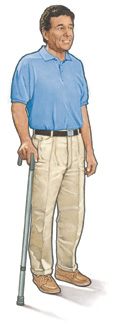Cane Selection and Use

Using a cane improves stability and balance by taking weight off of the leg opposite the side of the cane. There are 4 types of canes available. Each one provides a different amount of support. Ask your healthcare provider to help you select the type of cane that's right for you.
-
Quad cane. This has a rectangle base and 4 short legs. It comes in a small and wide base. This type provides more support than standard or offset canes. They're good for people who have weakness in 1 arm or leg. Or people who have moderate to severe pain with walking.
-
Hemi-walker cane. This is a combination of a quad cane and a walker. It's for people who have more severe weakness on 1 side. It's also for those learning to transition from a walker to a cane.
Cane size
Choose the right cane size for your height. When standing with your arm hanging down at your side, the top of the cane should be level with your wrist crease. When holding the cane, your elbow should have a slight (20°) bend. Ask for help when buying your cane if you're not sure about the cane size.
Cane use
These tips will help you correctly use your cane:
-
Using your cane properly will increase stability and balance while walking or standing. You should use your cane on the opposite side of your injury or weakness, regardless of which hand is your dominant one.
-
When you start walking, start by putting all of your weight on your strong leg. Then step with your affected leg and the cane at the same time. The cane and your weak leg should swing and strike the ground at the same time.
-
With your weight supported on both your cane and your affected leg, step through with your unaffected leg.
-
When using a cane for balance, plant your cane firmly on the ground before you take a step.
-
Going up and down stairs:
-
Toclimb stairs., Holding your cane on the side of your strong leg, grasp the handrail (if possible) with the arm of your affected leg. Step up with your good leg first. Remember: Up with the good. Then move the cane and your affected leg to the same step.
-
To come down stairs. First place the cane and the affected leg on the next step down. Remember: Down with the bad. Then, using the cane to support you and holding onto the handrail (if possible), lower the strong leg to the same step.
Preventing falls
Always be sure the tip on your cane is in good shape. A worn tip is more likely to cause a slip on ice, snow, or a wet surface. Use a wide tip that fits snugly on your cane. For winter use, ask about an ice-gripping device for the bottom of your cane.
Online Medical Reviewer:
Raymond Turley Jr PA-C
Online Medical Reviewer:
Stacey Wojcik MBA BSN RN
Online Medical Reviewer:
Thomas N Joseph MD
Date Last Reviewed:
5/1/2022
© 2000-2024 The StayWell Company, LLC. All rights reserved. This information is not intended as a substitute for professional medical care. Always follow your healthcare professional's instructions.